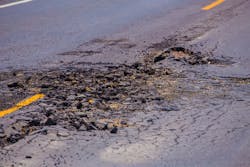“We cannot build a 21st century economy on 20th century infrastructure,” Tom Donohue, president and CEO of the U.S. Chamber of Commerce, declared in his 2018 State of American Business address in Washington Wednesday.
“This year can and must be the year of major infrastructure investment,” Donohue stressed. “We have the political will, the bipartisan support—and we certainly have the need. Now it’s time for action.”
Indeed, President Trump has put infrastructure at the top of his list for legislative action in 2018. According to a Washington Post report, Gary Cohn, the president's chief economic adviser, told Republican leaders on January 6 that the administration would propose a $200 million infrastructure bill that was designed to trigger $1 billion in spending by state and local governments and the private sector. However the paper reported that Trump had told leaders less than 24 hours earlier that he had misgivings about the public-private strategy.
Donohue said the nation needs to focus on infrastructure “projects of national significance that maximize long-term growth.”
He brought up a laundry list of infrastructure needs that affect manufacturers, whether it be the products they produce, the services that their operations rely on or the avenues that they use to receive and ship materials, parts and finished products.
“We need to rebuild our roads and bridges and modernize them for the technological changes to come, including driverless cars. We need to expand broadband so every American can access digital opportunities in the new economy,” said Donohue. “We must revitalize our seaports and airports to handle the demands of our increasingly global and mobile economy. Water supply systems must be updated—many for the first time in a century—so that basic resources remain safe and available.
“And don’t forget we’re also living in the midst of an energy renaissance, yet we don’t have the infrastructure to support it. So we must revamp our power grid and build the pipelines necessary to transport our abundant resources to market.”
But the Chamber leader brought up the most important issue that he noted has “dogged” infrastructure modernization efforts for years: “how do we pay for it?”
In “Water, Roads are Top Priorities for Local Governments,” an article on iconsofinfrastructure.com, author Michael Keating cited a survey by American City & County asking local government officials about their top infrastructure needs. Less than 13% said determining what projects to invest in was their biggest challenge.
Those officials put transportation (roads, bridges, tunnels) at the top (75.2%) of their list of needs with drinking water (68.8%) and wastewater (49.5%) taking the next two spots.
“Nearly two-thirds of respondents agreed that getting funding to pay for infrastructure improvement projects is their biggest challenge,” he noted. “When asked who should pay, respondents said that the federal government should pony up close to half the tab; local governments 39%; and the private sector should pick up the remaining 13%.”
The Chamber is hosting an infrastructure event on January 18 to help facilitate discussion between public and private leaders.
For continuing coverage of the infrastructure challenge and ways you can influence the national debate, visit Icons of Infrastructure, Informa’s new website dedicated to moving “today’s infrastructure to a better tomorrow.”
About the Author
Steve Minter Blog
Executive Editor
Focus: Global Economy & International Trade
Email: [email protected]
Follow on Twitter: @SgMinterIW
Call: 216-931-9281
An award-winning editor, Executive Editor Steve Minter covers global economic and international trade issues, tackling subject matter ranging from manufacturing trends, public policy and regulations in developed and emerging markets to global regulation and currency exchange rates. As well, he supervises content production of all IW editorial products including the magazine, IndustryWeek.com, research and informationproducts, and executive conferences.
Before joining the IW staff, Steve was publisher and editorial director of Penton Media’s EHS Today, where he was instrumental in the development of the Champions of Safety and America’s Safest Companies recognition programs.
Steve received his B.A. in English from Oberlin College. He is married and has two children.
